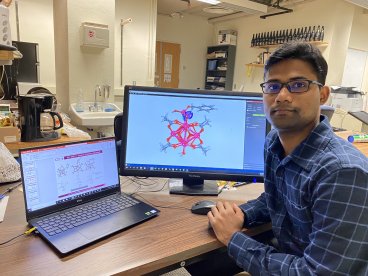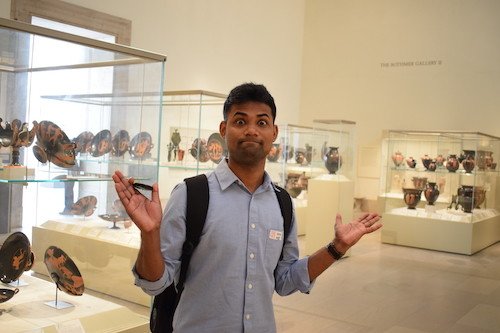Meet CTC: Mukunda Mandal

February 12, 2020 -- Mukunda Mandal is a fifth-year graduate student in the Cramer group. He is from West Bengal, India, and he began his work in the field of computational chemistry as a research trainee at CSIR-National Chemical Laboratory in Pune, India. Mukunda completed his undergraduate studies at the Indian Institute of Technology Bombay.
In addition to the Chemical Theory Center, Mukunda is also a member of the NSF Center for Sustainable Polymers (CSP) and the Inorganometallic Catalyst Design Center (ICDC). Within the CSP, Mukunda's research involves modeling polymerization reactions yielding biodegradable polymers from sustainable sources, such as corn or sugarcane. He also designs new generations of catalysts that can yield bioplastics from these sustainable sources in an efficient and cost-effective way. The bioplastics could take the place of their non-renewable counterparts, such as those that are petroleum-based.
With ICDC, Mukunda works on biomimetic model systems capable of oxidizing light hydrocarbons, which is a key step in biofuel production. His current research involves modeling a CO2 reduction reaction using metal-organic framework-based catalysts, which aims at recycling CO2 from the atmosphere into liquid fuels.
To perform his research, Mukunda uses the computing resources available at the Minnesota Supercomputing Institute. Since he often works with ‘large’ systems, he uses density functional theory-based methods routinely.
When he’s not doing research, Mukunda enjoys watching movies, especially Bengali films, which is his first language. He also enjoys watching soccer games. Mukunda, like many other members of the CTC, likes the Twin Cities because of public transport.

How did you become interested in studying chemistry, and what gets you the most excited about your field?
My high school chemistry teacher’s diligence in teaching chemistry made me fall in love with the subject (and, at the same time, I also started liking the teaching profession).
While it is not my field of research, yet, I’m most excited about the growing popularity of machine learning-based methods in almost every aspect of science, including chemistry. The ability to computationally screen thousands of molecules efficiently and shortlist the “best” ones for a given property is a remarkable achievement.
Why did you choose the University of Minnesota, and what led you to join your current research group?
Along with other divisions, the University of Minnesota (UMN) Department of Chemistry has multiple groups in the theory and computational subdivisions that are well-known internationally for their quality of science. In fact, in one of my undergraduate computational chemistry courses at IIT Bombay, the instructor spoke highly about the computational chemistry faculty here at UMN. We also used Prof. Cramer’s textbook in the class. This early introduction of the Department and, specifically, Prof. Cramer, played a big role in choosing UMN and the Cramer group.
What do you enjoy most about your research? What has been your most interesting or surprising finding so far?
Predictive modeling is always exciting. It is very cherishable when you predict the property of a system, or the rate of a chemical reaction using quantum chemical methodologies, and those predictions turn out to be accurate experimentally. Recently, another graduate student and I modeled a polymerization catalyst that was not reported before experimentally, and our collaborators at CSP synthesized that catalyst, which was found to be very efficient in catalyzing polymerization reactions. This is an exciting success story for us as it underlines the importance of experiment/computation synergy in our field of research.
What are you most proud of about your academic career so far, and what’s one thing you’d like to achieve in the future?
I enjoy teaching and discussing my work. During my undergraduate studies, I occasionally taught chemistry to students in my local school. At UMN, I was a teaching assistant in the first year. I enjoyed the experience a lot. I also served as a mentor for a high school student in the Cramer group, which was a very rewarding experience. In the future, I want to be in academia to be able to continue enjoying teaching and doing research.

What drives you to be a better scientist?
The highly interdisciplinary nature of research means that you need to have a general understanding of most of the things happening around you. One has to constantly look for opportunities to expand knowledge, skills, and expertise. This certainly is a great driving force for keeping your eyes open, learning about new things, and becoming “better” tomorrow than you are today!
